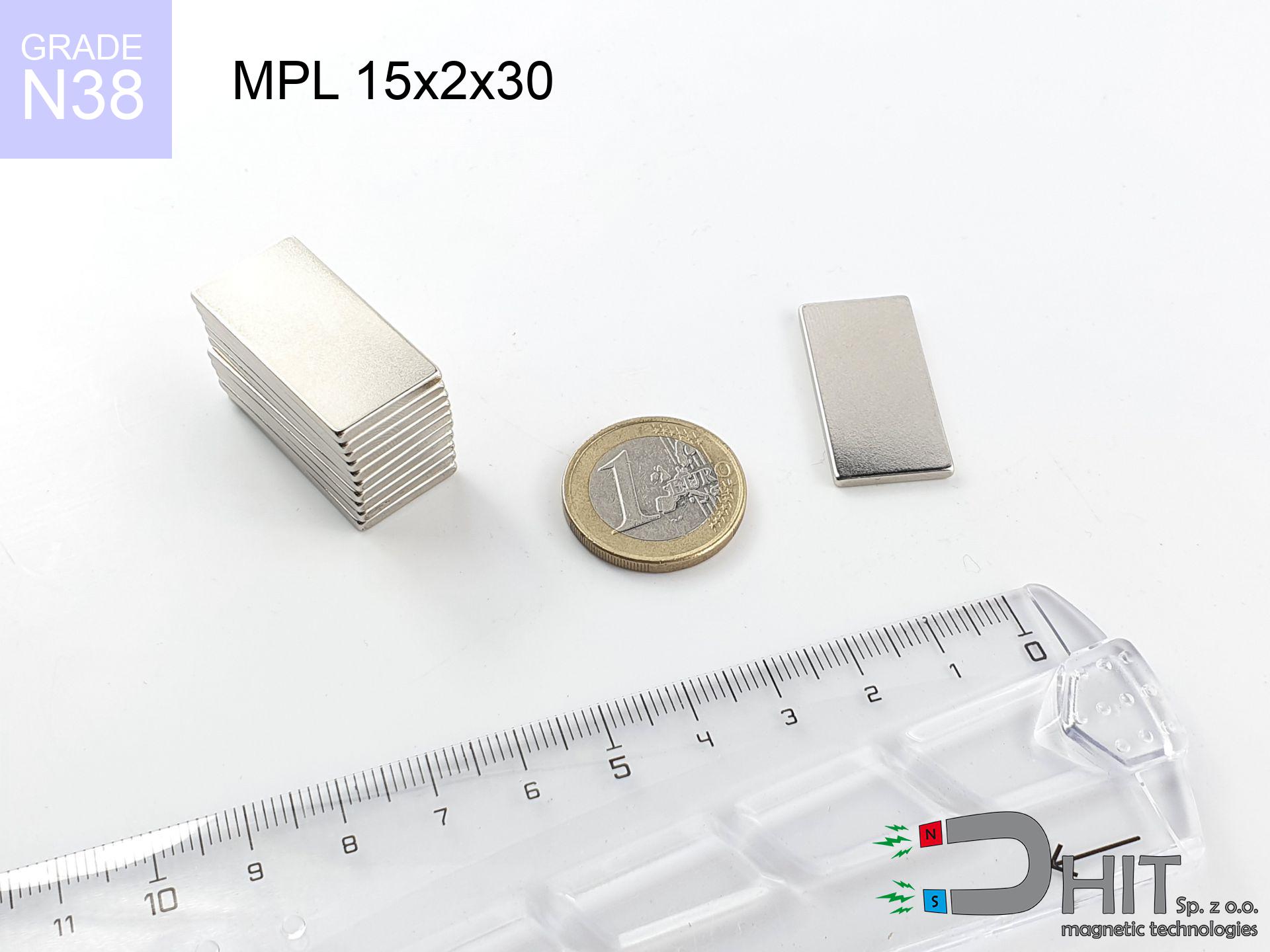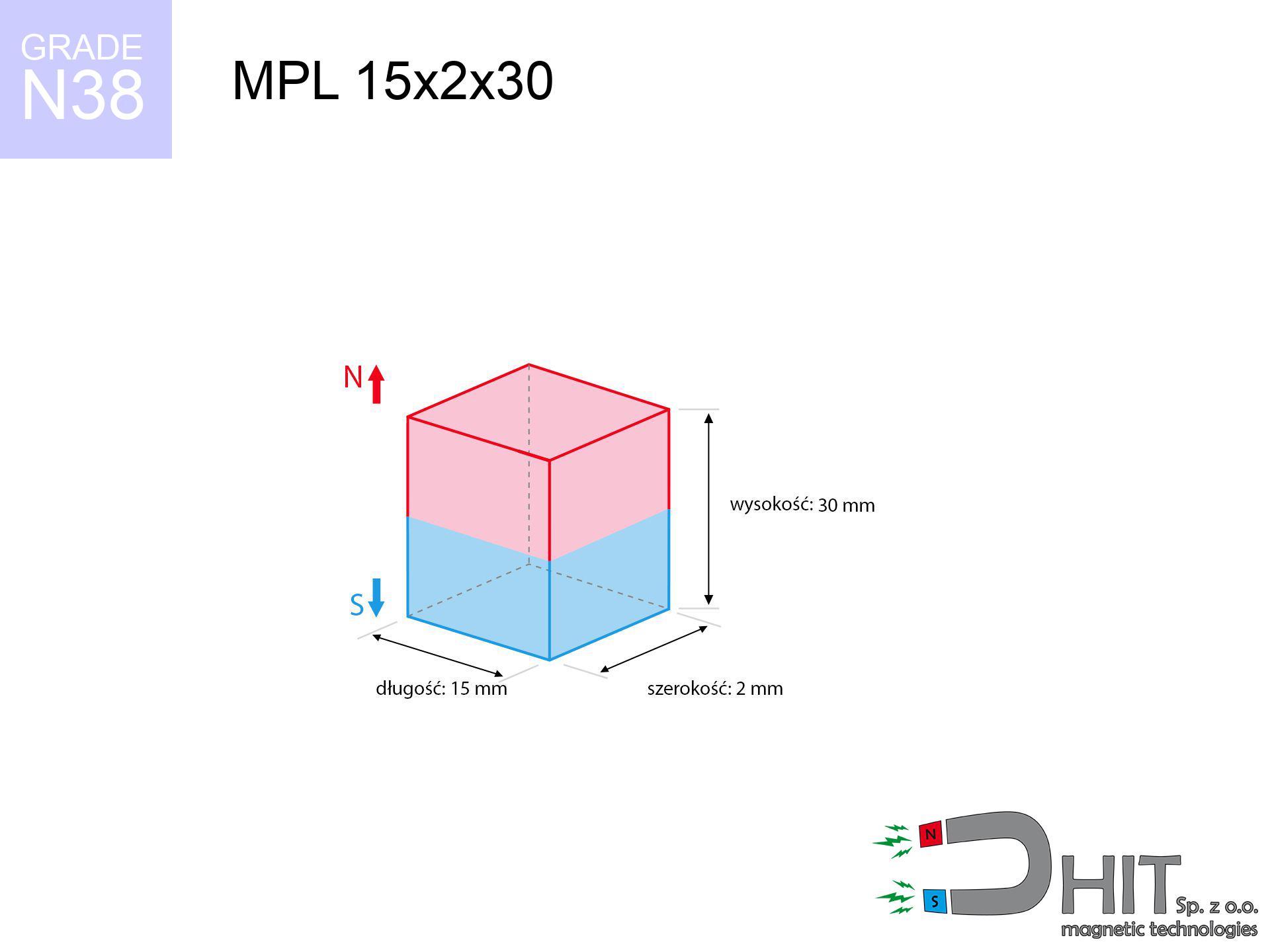MPL 15x2x30 / N38 - neodymium magnet
lamellar magnet
catalog number 020121
GTIN: 5906301811275
length
15
mm [±0,1 mm]
width
2
mm [±0,1 mm]
height
30
mm [±0,1 mm]
magnetizing direction
→ diametrical
capacity ~
2.73 kg / 26.77 N
magnetic induction ~
614.34 mT / 6,143 Gs
max. temperature
≤ 80
°C
catalog number 020121
GTIN: 5906301811275
length
15 mm [±0,1 mm]
width
2 mm [±0,1 mm]
height
30 mm [±0,1 mm]
magnetizing direction
→ diametrical
capacity ~
2.73 kg / 26.77 N
magnetic induction ~
614.34 mT / 6,143 Gs
max. temperature
≤ 80 °C
4.80 ZŁ gross price (including VAT) / pcs +
3.90 ZŁ net price + 23% VAT / pcs
bulk discounts:
need more quantity?Do you have questions?
Give us a call tel: +48 888 99 98 98 or get in touch through contact form on the contact page. You can check the mass and the appearance of magnet in our power calculator magnetic calculator
Orders placed by 2:00 PM will be shipped on the same business day.
Specification: lamellar magnet 15x2x30 / N38 → diametrical
Magnetic properties of the material N38
Physical properties of sintered neodymium magnets Nd2Fe14B
Thanks to their mighty power, flat magnets are commonly applied in structures that need exceptional adhesion.
Typical temperature resistance of flat magnets is 80 °C, but with larger dimensions, this value grows.
In addition, flat magnets often have different coatings applied to their surfaces, e.g. nickel, gold, or chrome, for enhancing their strength.
The magnet with the designation MPL 15x2x30 / N38 and a magnetic strength 2.73 kg with a weight of a mere 6.75 grams, making it the excellent choice for projects needing a flat magnet.
Contact surface: Due to their flat shape, flat magnets guarantee a larger contact surface with adjacent parts, which is beneficial in applications needing a stronger magnetic connection.
Technology applications: These are often used in many devices, e.g. sensors, stepper motors, or speakers, where the thin and wide shape is important for their operation.
Mounting: This form's flat shape makes mounting, particularly when it is necessary to attach the magnet to another surface.
Design flexibility: The flat shape of the magnets permits designers a lot of flexibility in placing them in devices, which is more difficult with magnets of other shapes.
Stability: In some applications, the flat base of the flat magnet can offer better stability, minimizing the risk of sliding or rotating. It’s important to keep in mind that the optimal shape of the magnet depends on the specific application and requirements. In certain cases, other shapes, like cylindrical or spherical, are more appropriate.
Magnets have two poles: north (N) and south (S), which attract each other when they are different. Similar poles, e.g. two north poles, repel each other.
Due to these properties, magnets are commonly used in electrical devices, such as motors, speakers, sensors, or magnetic locks. Neodymium magnets stand out with the greatest strength of attraction, making them indispensable for applications requiring strong magnetic fields. Moreover, the strength of a magnet depends on its dimensions and the material it is made of.
It’s worth noting that extremely high temperatures, above the Curie point, cause a loss of magnetic properties in the magnet. The Curie temperature is specific to each type of magnet, meaning that once this temperature is exceeded, the magnet stops being magnetic. Additionally, strong magnets can interfere with the operation of devices, such as compasses, magnetic stripe cards and even electronic devices sensitive to magnetic fields. For this reason, it is important to exercise caution when using magnets.
Choose recommended products
Advantages and disadvantages of neodymium magnets NdFeB.
In addition to immense strength, neodymium magnets have the following advantages:
- They do not lose their strength (of the magnet). After approximately 10 years, their strength decreases by only ~1% (theoretically),
- They protect against demagnetization caused by external magnetic field very well,
- Thanks to the shiny finish and nickel, gold, or silver coating, they have an aesthetic appearance,
- They exhibit very high magnetic induction on the surface of the magnet,
- Magnetic neodymium magnets are characterized by hugely high magnetic induction on the surface of the magnet and can operate (depending on the form) even at temperatures of 230°C or higher...
- Thanks to the flexibility in shaping and the ability to adapt to specific requirements – neodymium magnets can be produced in a wide range of shapes and sizes, which enhances their versatility in applications.
- Wide application in advanced technologically fields – are utilized in computer drives, electric drive mechanisms, medical devices and other advanced devices.
Disadvantages of neodymium magnets:
- They can break when subjected to a strong impact. If the magnets are exposed to impacts, we recommend using magnets in a protective case. The steel housing in the form of a holder protects the magnet from impacts, and at the same time increases its overall strength,
- High temperatures can reduce the power of neodymium magnets. Typically, after heating above 80°C, most of them experience a permanent loss in strength (although it is dependent on the form and size). To prevent this, we offer special magnets marked with the symbol [AH], which are highly resistant to high temperatures. They can operate even at temperatures up to 230°C, making them an ideal solution for applications requiring high-temperature operation,
- Magnets exposed to a humid environment can corrode. Therefore, when using them outdoors, we recommend using waterproof magnets made of rubber, plastic, or other moisture-resistant materials,
- The use of a cover - a magnetic holder is recommended due to the limited production capabilities of creating threads or complex shapes in the magnet
- Potential hazard arising from small pieces of magnets are risky, in case of ingestion, which is particularly important in the context of child safety. Furthermore, tiny parts of these products are able to complicate diagnosis after entering the body.
Exercise Caution with Neodymium Magnets
The magnet is coated with nickel. Therefore, exercise caution if you have an allergy.
Studies show a small percentage of people have allergies to certain metals, including nickel. An allergic reaction often manifests as skin redness and rash. If you have a nickel allergy, you can try wearing gloves or simply avoid direct contact with nickel-plated neodymium magnets.
Magnets made of neodymium are highly susceptible to damage, leading to breaking.
In the event of a collision between two neodymium magnets, it can result in them getting chipped. They are coated with a shiny nickel plating similar to steel, but they are not as hard. In the case of a collision between two magnets, there can be a scattering of small sharp metal fragments in different directions. Protecting your eyes is essential.
Neodymium magnets can become demagnetized at high temperatures.
Although magnets have demonstrated their effectiveness up to 80°C or 175°F, the temperature can vary depending on the type, shape, and intended use of the specific magnet.
Under no circumstances should neodymium magnets be placed near a computer HDD, TV, and wallet.
The strong magnetic field generated by neodymium magnets can destroy magnetic media such as floppy disks, video tapes, HDDs, credit cards, magnetic ID cards, cassette tapes, or other devices. They can also damage devices like video players, televisions, CRT computer monitors. Do not forget to keep neodymium magnets away from these electronic devices.
Neodymium magnets are not recommended for people with pacemakers.
In the case of neodymium magnets, there is a strong magnetic field. As a result, it interferes with the operation of a heart pacemaker. However, if the magnetic field does not affect the device, it can damage its components or deactivate the device when it is in a magnetic field.
It is essential to keep neodymium magnets away from youngest children.
Neodymium magnets are not toys. Do not allow children to play with them. Small magnets can pose a serious choking hazard. If multiple magnets are swallowed, they can attract to each other through the intestinal walls, causing significant injuries, and even death.
Keep neodymium magnets away from GPS and smartphones.
Strong fields generated by neodymium magnets interfere with compasses and magnetometers used in navigation, as well as internal compasses of smartphones and GPS devices.
Neodymium magnets are the strongest magnets ever created, and their strength can shock you.
Familiarize yourself with our information to correctly handle these magnets and avoid significant swellings to your body and prevent damage to the magnets.
Neodymium magnets are primarily characterized by their significant internal force. They attract to each other, and any object that comes in their way will be affected.
If the joining of neodymium magnets is not under control, at that time they may crumble and also crack. Remember not to move them to each other or hold them firmly in hands at a distance less than 10 cm.
Dust and powder from neodymium magnets are flammable.
Avoid drilling or mechanical processing of neodymium magnets. If the magnet is crushed into fine powder or dust, it becomes highly flammable.
To raise awareness of why neodymium magnets are so dangerous, read the article titled How dangerous are powerful neodymium magnets?.





![rubber magnetic holder external thread 22x6 [M4] GZ / N38 rubber magnetic holder external thread 22x6 [M4] GZ / N38](https://cdn3.dhit.pl/graphics/products/umg-22x6-m4-gz-hiw.jpg)
![magnetic holder with hook 36x8x46 [M6] / N38 ↑ axial magnetic holder with hook 36x8x46 [M6] / N38 ↑ axial](https://cdn3.dhit.pl/graphics/products/umh-36x8x46-m6-wim.jpg)

